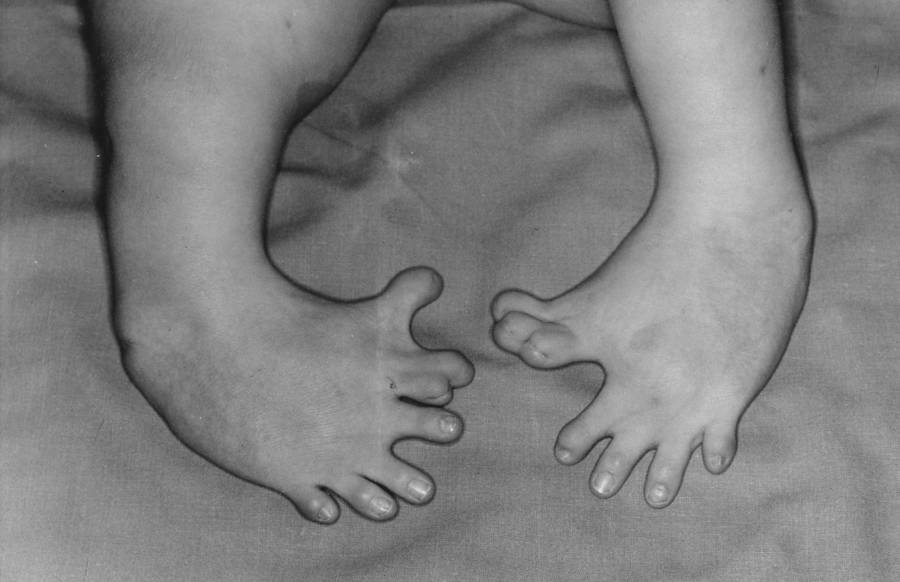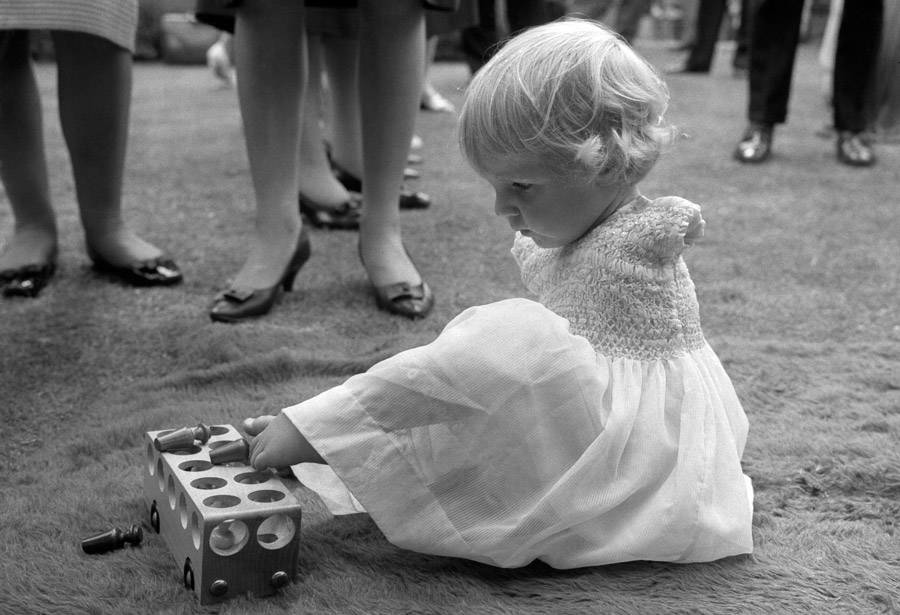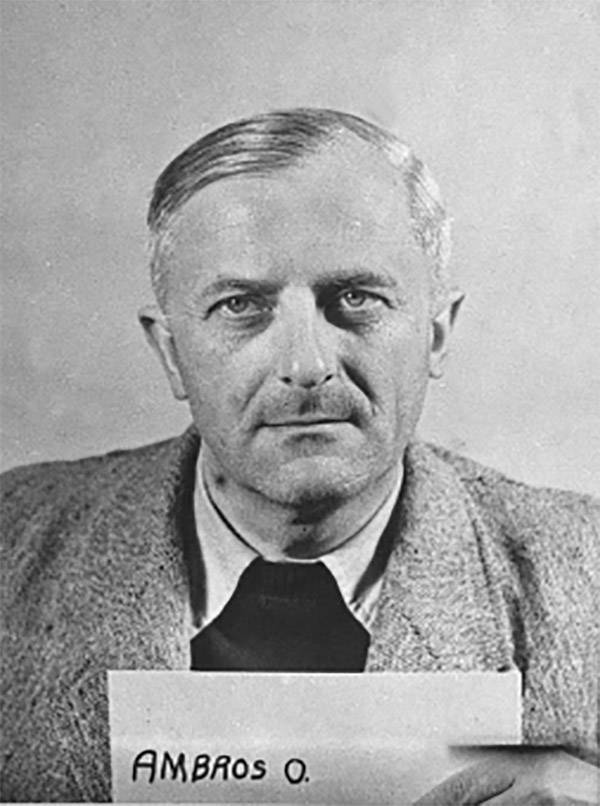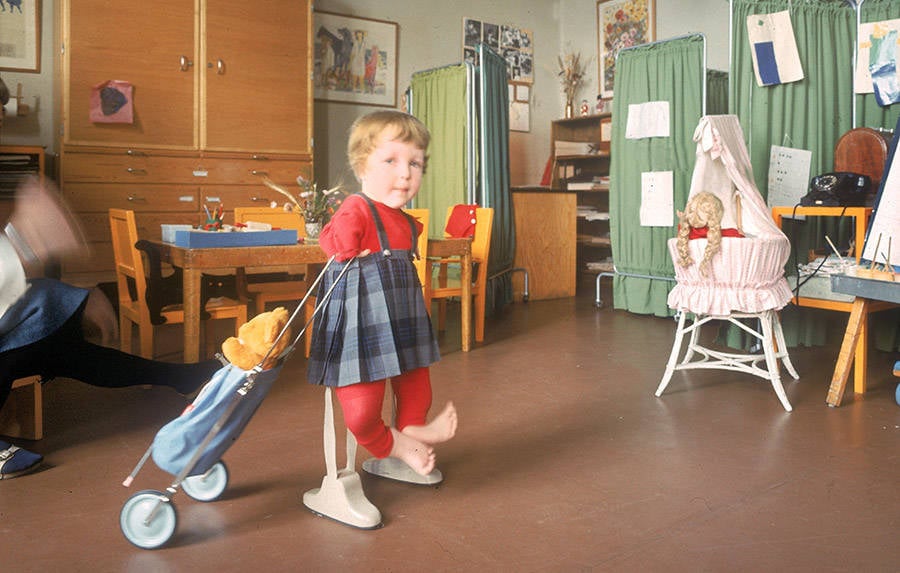Born with severe deformations, Thalidomide babies were the result of one pharmaceutical company's coverups and dark past.

Wikimedia CommonsThalidomide babies suffered numerous birth defects ranging from malformed arms, legs, and ears.
When Agnes Donnelion gave birth to her son Kevin, she wasn’t allowed to see him for two days. “All the mums in the ward were getting their babies and I wasn’t,” Donnelion recalled in the BBC documentary, Thalidomide A Wonder Drug. “…And so, I asked the sister [why] and she said ‘Oh you’ll see him tomorrow… Your baby is not too well.'”
When the moment came to see baby Kevin, the Sister took her to his cot in a wheelchair, as if to steady her when she saw her son. But when they arrived at his cot, the Sister just left Donnelion there and as she departed said “‘Oh by the way… He’s got short arms and legs.'” Donnelion didn’t really think much of the comment. “So when I lifted him up, [and] put the blanket around him, I got the shock of my life.”
Kevin Donnelion is one of over 10,000 thalidomide babies born worldwide. Like Kevin, many survivors have short, partially developed and twisted arms and legs, that resemble flippers. Others have deformed faces including malformed eyes and ears.

Getty ImagesPhillipa Bradbourne, a Thalidomide baby born without arms. 1963.
Many were born with no anus, no genitals, undeveloped organs and were so deformed, that death was certain. An additional 123,000 thalidomide babies (according to conservative estimates) were miscarried or stillborn. It is believed that many more unregistered infants died as a result of state infanticide.
Between 1957 and 1962, thalidomide was sold in 46 countries under 65 different brand names, aggressively marketed by Chemie Gruenethal, the German pharmaceutical company who developed it.
The official story is that thalidomide was discovered by accident by the company’s owner Hermann Wirtz in his quest to develop an anti-allergy drug. But while testing it on lab animals, he and his team found it had a sedative effect. They had discovered a new tranquilizer that could potentially replace barbiturates.
While barbiturates caused overdoses in high quantities, there was no such effect with thalidomide, at least in lab animals.
Thalidomide And Nazi Concentration Camps

Wikimedia CommonsOtto Ambros, the “Devil’s Chemist.”
But this is not the full story of thalidomide’s origins, according to Dr. Martin Johnson, the former director of the U.K.’s Thalidomide Trust. Johnson has gathered anecdotal evidence connecting the development of thalidomide to the Nazis.
Gruenethal employed a number of former Nazi scientists after World War II. Some worked directly on the development of thalidomide.
Wirtz himself was a former Nazi, but other more disturbing individuals were involved. Johnson believes the drug was developed by Otto Ambros, who was known as the “devil’s chemist” of Auschwitz. Ambros helped develop the nerve agent, sarin gas, and thalidomide was apparently tested as an antidote on inmates in concentration camps. This past is hinted at in the 1954 patent which states that human trials of thalidomide were carried out before Grunenthal’s official tests began.
Furthermore, another document shows the pharmaceutical company purchased the trade name Contergan from a French pharmaceutical company called Rhone-Poulenc, which was controlled by the Nazis. The French company was the only company to use the suffix ‘ergan.’ A total of 14 drugs developed in the early-1940s bear this suffix, and all demonstrate similarities to thalidomide.
According to Newsweek, Grunenthal buried anecdotal evidence of birth defects, of which the first documented case was a child of one of Grunenthal’s employees one year before thalidomide hit the market.
By 1957, the drug had become the best-selling sleeping pill in Germany and was soon popular throughout Europe as a treatment for morning sickness during the first trimester of pregnancy.
While increases in infant deformities skyrocketed around the globe, the tenacity of the FDA’s Dr. Frances Oldham Kelsey prevented a similar disaster occurring in the United States (only about 17 cases were reported). The FDA never approved the use of thalidomide thanks to Dr. Kelsey’s concern with the lack of clinical trials, lack of tests on pregnant animals, and insufficient reporting of its adverse effects by William S. Merrell, an American drug company. Her work led to a tightening of the FDA’s authority of drug testing in general.
Thalidomide was taken off the market in summer of 1962 after mounting evidence placed increasing pressure on Grunenthal when scientists discovered that the drug damages the fetus in the first 60 days of pregnancy.

Wikimedia Commons/LIFE Picture Collection/Getty ImagesArtificial limbs that were commonly worn by thalidomide children in the 1960s. A German baby girl, born armless as a result of her mother taking the tranquilizer thalidomide wears a harness fitted with prosthetic arms and tiny boxing glove-like hands.
Now, thousands of thalidomide babies and their families had to find new ways to cope and gain some semblance of a normal life. Many didn’t. Babies were left to die by midwives, while others were abandoned by parents. Some parents committed suicide.
Many thalidomide babies underwent painful operations and were fitted with crude artificial limbs:
“They were totally unfunctional,” recalled Kevin Donnelion. “…[Special] arms which are activated by gas cylinders which you move your shoulder and then the claws would open. Most of the time you just drop things… The gas wouldn’t last that long, and sometimes you’d be picking up a cob, say, and you’d get it halfway to your mouth and then the gas would run out. The legs in some way were worse because they were far more dangerous. I mean these legs were extremely heavy, you know…With having no arms I couldn’t save myself if I fell over… I’ve got loads of stitches in the back of my head.”
Thalidomide Babies Today

A rehabilitation center for children victims of Thalidomide in Oslo. 1964.
Despite severe disabilities, many thalidomide babies grew to have fulfilling lives and families of their own. Louise Medus, who is married to Darren Mansell, himself a thalidomider (as many adult survivors call themselves), have two dogs and two round-the-clock carers.
Her father spearheaded a lawsuit against Distillers the British distributors of thalidomide, winning a settlement of £26 million ($35.8 million) for 370 families, and which led to the formation of the Thalidomide Trust in the U.K. Medus, herself, was a member of the Trust’s National Advisory Council (NAC).
She has tried to achieve as much as people living a normal life, maybe even more so. She has worked in insurance, learned to drive an adapted care, and has written a memoir, No Hand To Hold & No Legs To Dance On.
Medus, also, has two grown children from her first marriage. Despite the possibility of deformities being passed down to the children of thalidomiders, Medus’ children do not have deformities. Medus has been estranged from her own parents and siblings but is close to her children. “Thalidomide has not only affected the survivors,” Medus told The Guardian in 2014. “[I]t has affected the survivor’s siblings, their parents, and their children. So you don’t just have a thalidomide baby – you have a thalidomide family.”
Is Thalidomide a Wonder Drug?

LIFE Picture Collection/Getty ImagesA kindergartner crippled by drug Thalidomide writes with aid of pencil-holding device. 1967.
Despite its catastrophic effects on pregnant women, thalidomide is somewhat of a contradiction.
In Jerusalem, just three years after thalidomide was removed from shelves, Dr. Jacob Sheskin made a startling discovery after he sedated a patient with thalidomide. His patient was one of 5-percent of leprosy sufferers who are afflicted with erythema nodosum leprosum (ENL), a condition that causes deep painful skin lesions on the face, arms and thighs which can lead to deformities.
Remarkably the skin lesions disappeared overnight. Dr. Sheskin’s results led to thalidomide being administered to leprosy sufferers around the world. The use of thalidomide to treat ENL caused more cases of thalidomide babies, especially in Brazil.
More recently, thalidomide is being used to inhibit blood flow to tumors, to treat various cancers, reduce the inflammatory effect of Crohn’s disease, alleviate complications of HIV, and even to help reduce chances a donor organ will be rejected by the new host’s body.
However, long-term use of thalidomide has also been found to cause neuropathy, a painful condition caused by damaged nerves usually in the arms and legs. But there is hope. With thalidomide’s positive benefits, it is hoped new research conducted by various medical institutes will help develop ways around the drugs harmful side effects.
Next, read about Joseph Merrick, “The Elephant Man” who just wanted to be like everybody else. Then learn about the “Tree Man” Syndrome that turns people into living, breathing pieces of bark.




